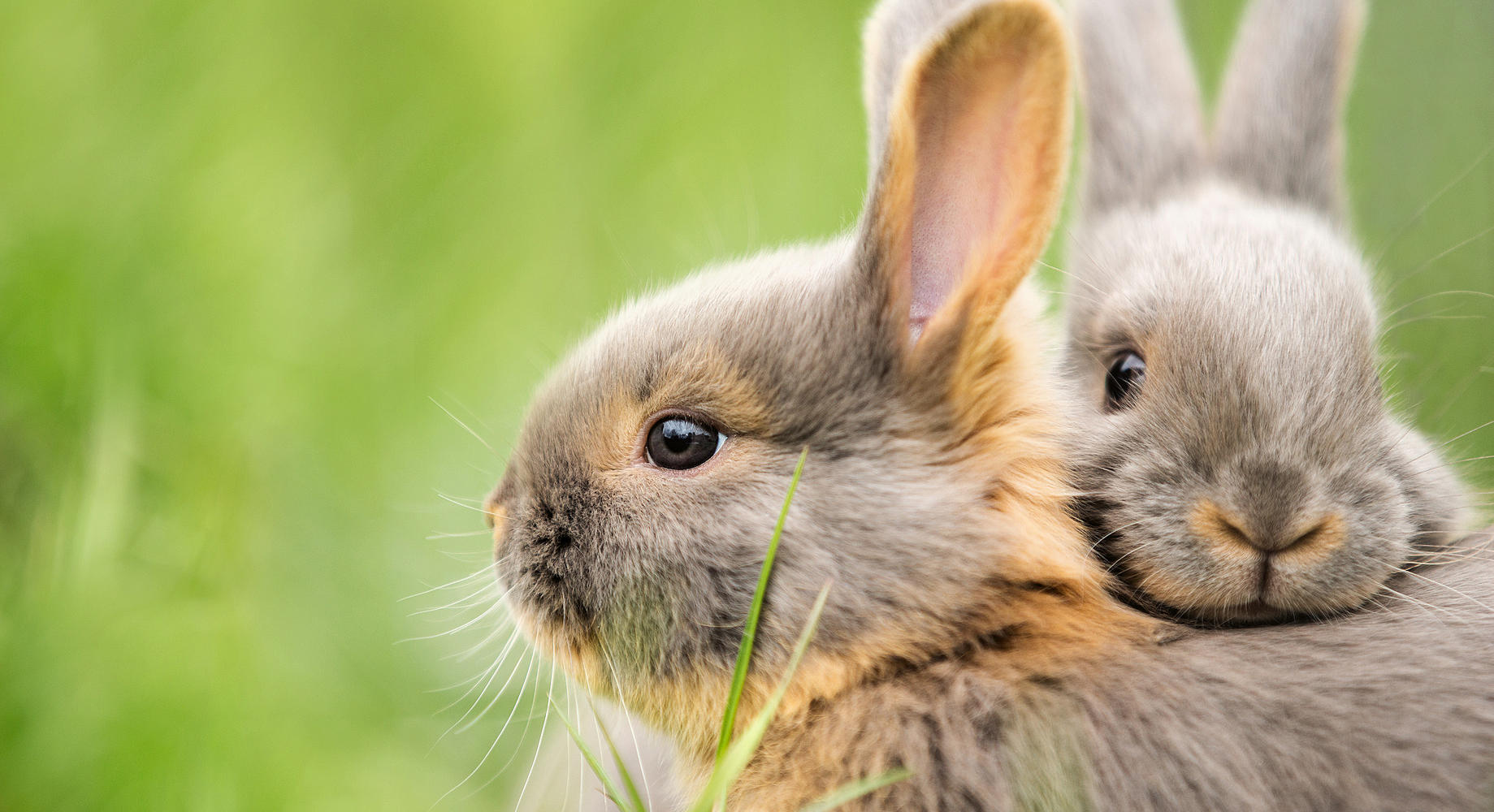Rabbit Companionship & Bonding

Companionship: Rabbit Bonding
Top Tips for Bunny Bonders!
With February traditionally being the month of love, we are taking a look at companionship and rabbit or bunny bonding.
There’s nothing better than seeing two bunnies snuggling together, and as a ‘prey’ species, rabbits actually need companionship for their own mental wellbeing.
And whilst some rabbits can bond well with humans for companionship, rabbits are happiest with their own kind, but how do you bring two rabbits together - and what happens if it doesn’t work right away? Rabbit bonding is more of an art than a science and we’re here to help you to help your little ones!
There’s a number of guides from reputable rabbit groups that focus on the bonding process, and our blog focuses on helping you, their carer, to have a better idea on what to expect, how to manage it, and to help sooth those bonding nerves before you start!
See our links below for further information too.
Bonding - What’s It All About?
Bonding rabbits is the joining together of two (or more!) rabbits that have previously been living alone. Once bonded, the rabbits will spend the rest of their lives together. As already mentioned, rabbits need companionship for their fundamental wellbeing.
The best type of bond, ideally, is between a neutered male and a neutered female. Other partnerships are possible, as is the creation of a larger group, but it's often better to start simply and start small - especially if you have no previous bonding experience.
We all think of rabbits as cute, fluffy little creatures, but they can be fiercely territorial and can cause serious injury if challenged. So bringing two rabbits together needs to be planned carefully and the process of bonding carefully undertaken.
Think of bunny bonding as a little like dating - rabbits have to get to know each other, learn to trust each other and learn to live together before they make the big commitment of a life-long partnership. Otherwise another rabbit can seem as a threat or an aggressor … a little like ‘stranger danger’!
And whilst, on occasions, two bunnies can fall into ‘love at first sight’, bunny bonding normally takes skill, patience, much time … and, on occasions, nerves of steel!
The ‘slow and steady’ method of bonding, where the rabbits have a number of supervised ‘dates’ is a well established and manageable process, and can be fitted in around your daily commitments, and allows you, the bonder, to set the pace and control the entire bonding process.
Before You Start
There’s no doubt preparation is key to a good bond. We’ve listed a number of links to sources of reputable rabbit bonding information for your reference at the end of this blog, and have highlighted some of the key points for you to consider - our top tips for a smooth, and hopefully successful bond.
1. Neutral Area
Bonding should be carried out in a small, safe and controllable area where none of the rabbits being bonded have ever been. This is important, as familiarity can give rise to the feeling of territory which would need defending! A bathroom often works well. If there’s no ‘neutral’ area, a thorough cleaning of the proposed room with white vinegar can help to remove familiar scents and smells. And perhaps a friend, family member or a neighbour can offer a room!
2. Create a plan for the duration of the session
- How will the rabbits will be brought into the bonding space, as an extra pair of hands will be great if you don't have two carriers!
- How will they be kept apart until you are ready to start the bonding process - perhaps in their own separate carriers?
- Is there anywhere you can put the carriers out of the way during the bond? The last thing you need is loads of obstacles to navigate around if you need to act quickly.
- How long will the session be? It’s a good idea to stick to this timing - especially in the early bonding sessions. There's always a temptation to carry on for a bit longer, but it's better to end the session on a positive note, rather than having to intervene as things started to deteriorate.
3. What to do if it all goes wrong
A sturdy pair of gardening or oven gloves to prevent being bitten is essential - you may need to intervene if you feel things getting tense and you need to stay safe. An extra pair of hands to help would also be great, but not essential if you're comfortable grabbing a bunny quickly if the need arises. A carrier at the ready to separate one and, without being dramatic, also think about first aid in case there’s an injury to either rabbit - or human. It’s rare, but does happen, and being ready for it as a possibility will help you cope if the need arises.
4. Distractions
Let the rabbits have a few things to nibble on or explore whilst they are in the same area as the other rabbit - distraction is good, and best to have a few things to keep them busy so there’s no chance of one being possessive about an item. But don't overload the area - after all, it is about letting each rabbit learn about their new companion.
5. Calm
Do you have a calming diffuser that may help give both bunnies 'calming vibes'? Pet Remedy and RabbitComfort can work wonders and are available in spray, plug-in and wipe form. They can be particularly beneficial at the start of the bonding process, or if the bond has stagnated or taken a step backwards.
6. Neutering
Are both rabbits neutered? This is best for rabbit health (most un-neutered males and females develop forms of cancer at a relatively young age) and neutering is definitely best for a successful partnership - hormones can cause a great deal of trouble!!
Speak to your rabbit savvy vet for guidance on neutering, and check with your vet as to how long it should be left before bonding can start after neutering - there's both the issue of surgery wounds healing and ensuring there is no risk of an unwanted litter ...!
The Rabbit Welfare Association has published a list of Rabbit Friendly vets around the UK which can be found here: RWA Rabbit Friendly Vets
7. Take a deep breath! And keep calm
Rabbits will be able to sense your feelings and if you project a feeling of calm and control, it will help.
If you feel yourself becoming anxious or stressed, stop and take a break. There is no limit or set number of sessions you must do in a set number of days; you are setting the pace and what is comfortable for you is what is right for your bonding bunnies.
If you feel you need a week to gather your confidence, great! You’ve taken an important - big - step of being in control!
In the beginning ..
The principal of bunny bonding is simple; the rabbits are brought together in a neutral environment for a short space of time. This can even be just a few minutes at the start of the process.
During the time they are together, they should not fight as this will lead to distrust and make the next session a little trickier at the start - and if the fighting continues, each session will then become harder and harder.
Ideally, initially there should be no interaction at all. It may sound odd, but two rabbits ignoring each other is actually a good sign!
Your role as chief bonder is to read their body language and anticipate what each rabbit is thinking and prevent anything negative from occurring before it happens whilst they are in the same space together.
Sounds simple enough, right???!
As silent creatures, rabbits can be difficult to ‘read’. Ears are a good indication of their feeling as is a change from their normal body stance, and overall behaviour. Ears totally upright can be a sign of curiosity, whilst at a 45 degree angle can indicate aggression or nervousness. It’s all in the angles!
If you feel something negative may be developing, it is your job to stop it from going any further. This can be achieved by simply offering a diversion - a tasty treat, clapping hands, rolling a ball between them etc - explore a few different ideas and see what works - and maybe have a few ‘escalating’ distractions in case the first doesn’t work. And if nothing works, and you are worried something may happen, end the session there. Don’t wait until after something negative happens.
And once your time is up, especially in the first few sessions, end it there and then by separating them both back into their own usual living areas. It may be tempting to continue the session, but in the early days it’s better to end on a positive. If nothing has happened and they both ignored each other, pat yourself on the back for a job well done!
And that’s it! The first session is over and you can breathe a sigh of relief! Going forward, each future session follows along the same process of bringing the rabbits together in the neutral environment, allowing them to potter around, and intervening before anything negative happens. The frequency and length of each session is up to you and your timescale - maybe the first few sessions are once a day, then a few sessions twice a day; it’s really up to you.
One step forward ..
Don’t be disappointed if you feel the need to slow things down. Even if you’ve had several ‘good sessions’ you may feel you need to slow things down by shortening a session, or having a few days break in between if a session doesn’t go quite as well as the last. Bunny bonding is not an exact science and taking one step forward followed by two steps back is quite normal!
And on rare occasions, especially if a new bond is created just before spring when all critters become a little frisky (!), something can sometimes trigger a bond breakdown. it’s not common, but can happen. Just have a plan in case - getting back to the status quo can be as simple as separating the bunnies for a while then starting the bonding process again. Sometimes absence make the heart grow fonder in rabbit world too!
Maybe start a bond in summer once the ‘joys of spring’ have moved to the chilled vibes of mellow sunny summer days!
It’s a fine line …
One aspect of bonding which can be challenging for inexperienced bunny owners to interpret is knowing what is a fight and what is part of normal dominance behaviour - within many partnerships, one rabbit may be the dominant (and this can be the female or male) and ‘hump’ the other. Whilst this behaviour is normal, it can also quickly escalate into a very aggressive fight if the ‘humpee’ is not ready to be submissive.
It is also not uncommon for the ‘humper’ to mount the facial area rather than from behind. This is extremely dangerous and can lead to significant injury.
This behaviour can be quickly interrupted by distraction, and total separation if necessary. Aggression must be prevented.
Not quite so cute and fluffy now, are they??
When is the Deal Done?
You’ll know when they are ready for full domestic bliss together. The good signs to look for are eating nicely together - sharing a bowl of food or eating treats together, mutually grooming each other simultaneously (this is so lovely to watch!), and rolling on their sides in a heap and snoozing together.
Then, your work is done!
Further Resources
So now armed with some top tips, we hope you’ll find the bonding process a little more manageable and less stressful and daunting.
We’re here to help if you have any specific queries, and the following links are also a good source of reference:
Rabbit Welfare Association (RWA)
Rabbit Friendly Vet List: https://rabbitwelfare.co.uk/rabbit-welfare-association-fund/our-work/rabbit-friendly-vets/rabbit-friendly-vet-list/
RWA Guide to Bonding: https://rabbitwelfare.co.uk/rabbit-care-advice/ownership/bonding-rabbits/
RSPCA
Bonding Guide: https://www.rspca.org.uk/adviceandwelfare/pets/rabbits/company/bonding
PDSA
Bonding Guide: https://www.pdsa.org.uk/pet-help-and-advice/looking-after-your-pet/rabbits/how-to-help-your-bunnies-bond





